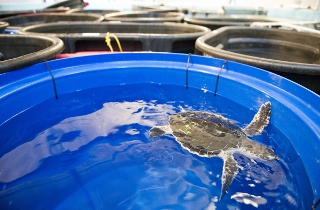First-time Mission
By Julie Flaherty
Sea turtles are among the wildlife affected by oil spills, and experts are just now learning how to care for them

A Kemp’s ridley turtle recuperates in one of the tanks at the Audubon Nature Institute outside of New Orleans. Photo: by Alonso Nichols
Soon after the Deepwater Horizon explosion, biologists saw that the oil spill would saturate important feeding and nesting areas for five species of turtles, including the critically endangered Kemp’s ridley. It was like setting off a bomb in turtle Grand Central. Because spills affecting large numbers of turtles are rare, the turtle rescuers who arrived on the scene did not have years of de-oiling practice on their side, like the bird rehabilitators. They were essentially starting from scratch.
Capturing the animals was the easiest part. Gulf turtles—Kemp’s ridleys, greens, loggerheads, leatherbacks and hawksbills—spend the first few years of life hanging out near the lines of sargassum, a type of seaweed that is home to the crabs and other invertebrates the turtles eat.
“The oil followed the same flow patterns that the sargassum did,” said Terry Norton, V86, just returned from a week caring for turtles at the Audubon Nature Institute’s aquatic center, outside New Orleans. “Normally when you look in there,” he said, “they are so fast it’s hard to catch them.” But in their oiled state, the turtles “were a lot slower and easier for rescuers to catch,” said Norton, the founder and director of the Georgia Sea Turtle Center on Jekyll Island.
More than 450 oiled turtles were found alive, and many of them were brought to the Audubon aquatic center for cleanup and care. But how to go about it? The scientific literature offered only one small study, published in 1995, that tested five turtles that were exposed to weathered South Louisiana crude oil. It warned of peeling skin, salt gland malfunction, pneumonia, gastric ulceration and organ failure. It also ominously stated that “the long-term biological effects of oil on sea turtles remain completely unknown.”
Improvisation reigned. The aquatic center had been designed to care for only a handful of turtles at a time, so it had to be retrofitted with new tubs and filtration systems. Kiddie pools became easily maneuvered wash basins. Plastic spatulas and credit cards helped pry open strong but delicate turtle jaws. And the blue fabric ribbons standing in for seaweed in the holding tanks were the same kind of strips you would find swaying in an automatic car wash.
But perhaps the most versatile tool was mayonnaise. It cleaned the oil out of the turtles’ eyes and mouths the way cold cream removes greasy makeup. Later, when the turtles began regurgitating and inhaling the doses of activated charcoal that were supposed to bind the oil in their guts, the veterinarians looked again to their favorite condiment. They mixed the mayo with cod liver oil—to thin it and provide extra nutrition—and tubed it down the turtles’ throats. “We still have no idea if it’s working,” Cara Field, an Audubon veterinarian, said in August. But unlike the charcoal, “it doesn’t seem to have made them worse.”
In fact, of the 182 oiled turtles they had taken in as of mid-August, only three had died—a wonder considering how fragile they are in captivity. “The capture, transport and intake process is extremely stressful,” said Norton. One small hawksbill he treated weighed less than a pound. As they cleaned him, his heart rate dropped from 30 beats per minute to just four, which is moribund even in turtle terms. It took emergency measures to save him, but he recovered.
For the moment, the veterinarians were relieved to find the disorders they had been warned about did not materialize, even though many of the turtles clearly had ingested oil. (Some still had oil in their waste a week later.) They were also pleased to have this nursery full of reptiles, which taught them a lot about juvenile turtles in general, including their body weights, their blood values and the healthy and unhealthy things they eat in the wild. “We did find a lot of plastics in their feces,” Norton said.
For a lesson in resilience, they can turn to turtle number 108. The thick coating of oil he came in with may have been the least of his problems. Jagged holes on the top and bottom of his shell pointed to a run-in with a shark. One flipper had to be amputated early on. “He’s got some issues with his lung,” said Field, the Audubon vet. “And he still has broken bones that are healing.”
But the vets were optimistic that he would return to the wild.
“They do OK missing one, sometimes two flippers,” Norton said. “They are pretty tough animals.”
This story first appeared in the Winter 2010 Tufts Veterinary Medicine magazine.
Julie Flaherty can be reached at julie.flaherty@tufts.edu.
